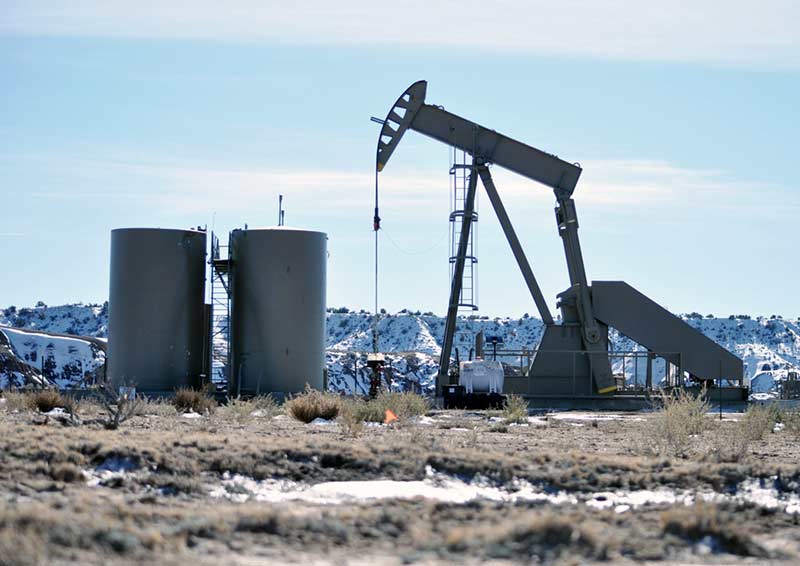
50 Years Ago: Secrecy over oil production raises questions

Many oilrigs, like this one, are set up near the Lybrook Ariz., area. (Times photo – Ravonelle Yazzie)
There is a lot of speculation about why companies drilling for oil on the Navajo Reservation have imposed on themselves a ban on releasing any information to the public for six months about how much oil they are taking out of the ground.
This has never happened before and the question that a lot of people are asking is whether this vow of secrecy was requested by the tribe or the U.S. Bureau of Indian Affairs.
The tribe currently hasn’t set a date for the next oil drilling lease 0sale and production so far in 1967 has been steady so all one had to do to get an idea of how much oil is being drilled is to go to past figures.
Kerr-McGee and Humble Oil, for instance, reported production in March of 59,000 barrels as compared to 132,000 barrels for oil production for the entire state of Arizona.
So oil production on the Navajo Reservation is booming but for some reason someone wants to keep how well the companies are doing a secret.
In other news, Navajo Tribal Chairman Raymond Nakai has an idea on how to make the reservation more appealing to tourists– guides.
He said the average tourist is always in a hurry and wants to see as many sites as he can in as short a period as possible. That’s why, said Nakai, the tribe needs to build good roads throughout the reservation that will take tourists to the main attractions with as little problems as possible.
But he also wants offer more than just seeing the scenery.
“Many of our people pursue lives and customs such as our ancestors did in this past century,” Nakai said. “This is of great interest to the tourist, most of whom have no knowledge of the way of life of our people.
“Unfortunately, however, the tourist is not in a position to understand and evaluate that which he may see on our reservation.” Nakai said. “To get the most from his visit, he should be furnished with a guide, appropriately informed, who is in a position to explain the significance of all phases of Navajo life, its history, language, religion, ceremonials and the like.”
Nakai said he was toying with two ideas: The creation of touring buses that would originate in Flagstaff, Gallup and Farmington; and the possibility of hiring Navajos in all the major tourist areas on the reservation, giving them a little training on Navajo history and how to convey this to tourists and allow them to give tourists a one-day experience.
The community guide program would create a couple of hundred jobs and not only would provide income to Navajo families but would help promote the reservation as a tourist attraction.
At the time, he seemed to be excited about the idea but nothing happened although he would bring this up again when he ran for re-election in 1970 against Peter MacDonald.
The big news in the eastern portion of the reservation this week was the sight of more than 30 workers from the Navajo Area Indian Health Service out of Crownpoint and Tohatchi dusting prairie dog villages.
IHS crews had been conducting surveys of the villages in the last several weeks and sending samples to San Francisco to test for the presence of plague.
So far, according to IHS officials, there have been no positive results but the IHS plans to spend more than $50,000 this year on testing and dusting to try to cut down on the number of plague cases.
IHS officials said that tests done during the winter months, when the prairie dogs hibernate, revealed that some 37 species of animals, including dogs and small rodents, have been found to be carriers of the disease.
And finally by April, 1967, Nakai was weeks into his second administration and decided it was time to start getting rid of people in his first administration who he felt didn’t support him enough in his 1966 and 1967 campaign.
Within weeks, 10 top administrators, including Sam Billison, his opponent in the last election, were out and new administrators were named to take their place.
By early May, Edward McCabe Jr. had been named director of the tribe’s administration division, Donald Brunton the new controller, Wilfred Bowman the deputy controller, Wilbur Dixon the director of Public Services Division and Leo Watchman, the tribe’s new treasurer.
These were the men Nakai hoped would help him in the next four years to bring his goals to fruition.
As for Billison, he found himself employed just days after being fired by the Navajo Tribal Council, accepting a four-month position as field director for the Arizona Neighborhood Youth Program.
Afterwards, he planned to go to the University of Arizona in the fall to complete his doctorate studies in education.
To read the full article, pick up your copy of the Navajo Times at your nearest newsstand Thursday mornings!
Are you a digital subscriber? Read the most recent three weeks of stories by logging in to your online account.







 Highway 264,
Highway 264, I-40, WB @ Winslow
I-40, WB @ Winslow